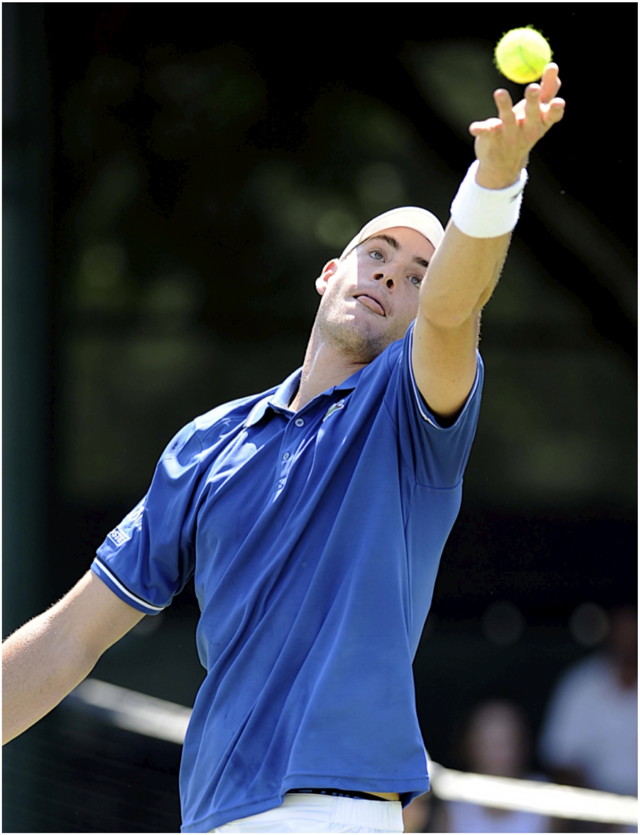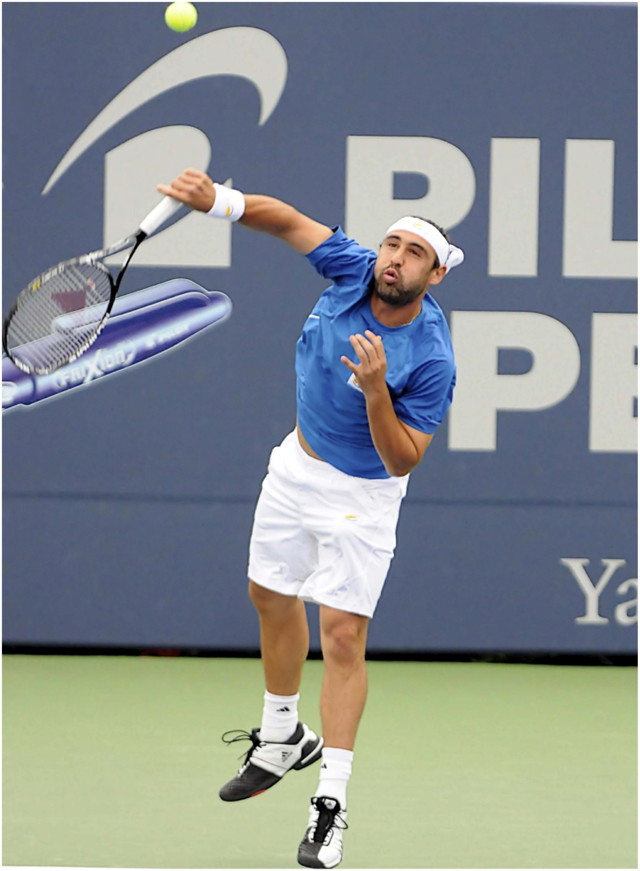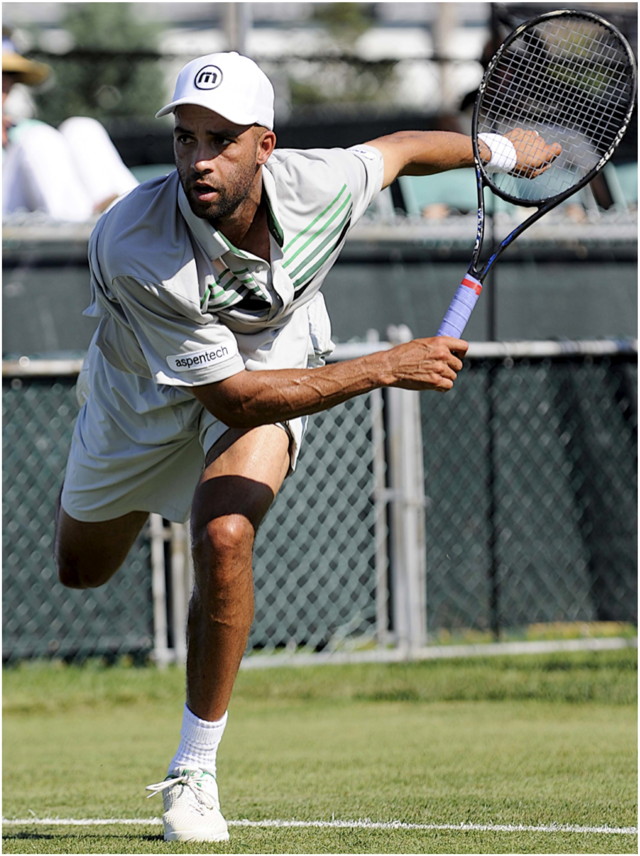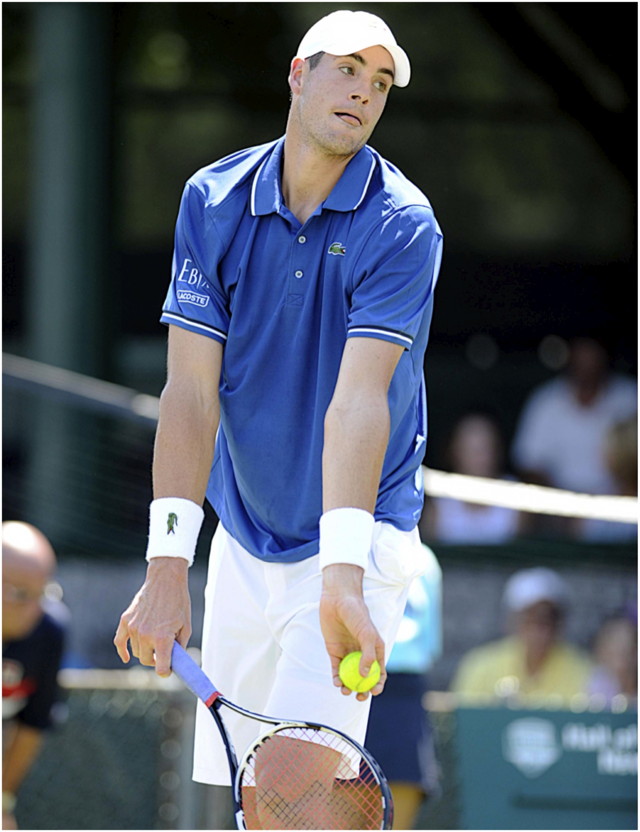August 2013 Article Turbo Tennis Archives:
Tennis Server
|

 |
The Modern Serve
This July, I had the great fortune to photograph the Newport Hall of Fame Championships. Apart from the great induction ceremonies, the 32 man draw is quite a wonderful treat after Wimbledon. Grass court tennis, which is the Newport surface, is very different. Unlike Wimbledon, the grass at the Newport Casino is of the traditional variety. It is very fast, creates unpredictable bounces and rewards those who are blessed with a big serve.
I prefer first serves to be hit with an apex toss... whether they are hit flat or with slice. For second serves, I generally prefer the kick serve. Kick serves can be hit with either an apex toss or a high toss with ball descent. Hitting a kick serve "on the rise" can be done, but it is not easy. Each reader needs to experiment with toss height for the various serves he/she uses. Obviously, the complexity of your service motion style dictates which tosses may be out of the question. I doubt sincerely that a person with the classic, traditional, circular service motion is able to hit a serve "on the rise." If you use a very economical service motion, you probably cannot make consistent contact with the ball if it is beginning its descent. Trial, error and video analysis will help you answer the question, "How high should I toss my ball when serving?" There is an inherent advantage to a lower toss... wind conditions do not affect the movement of the ball as significantly. Kick serves which bounce up require a toss that is less in front of the body than flat or slice serves. Indeed, the toss is really made so that the ball is elevated behind your head. Let me add one more note about serve toss. Good serve tosses are made when the fingertips of the non-dominant hand hold the ball and when the toss generates little or no ball rotation. This requires some practice and again a relaxed tossing hand and arm. Below, note the relaxed, fingertip toss of John Isner. In reality, he "throws" his balls using his thumb and first three fingers. The ring finger and pinky are essentially out of the picture when he tosses.  THE LEG LAUNCH A major source of power in the serve is how much "leg" you put into your service motion. The more you bend your needs and launch yourself upward, the more power you will generate. John Isner is a tall man! He launches his tall frame up significantly as he serves... especially on the first serve. Despite his rather slim frame, Isner's legs are able to help him generate speed and pace in his serves. Literally, John is airborne when he makes contact with the ball as he serves. The more airborne you can become with respect to your service motion, the better. Why? Not only do you have more power in your serve, you also are making contact as if you are a taller person. The taller you are the more of the service box you can see over the net. The more of the service box you can see, the more likely it is that you can place your serve within the box! WRIST AND PRONATION These two elements combine to form another source of major speed and pace in the serve. A player must pronate during the serve or she/he will hit the ball with the side of the racquet head (its frame). We do this naturally without thinking about it. For righties, pronation is really like "unscrewing" a light bulb. It is essentially the same arm/wrist motion. For lefties, pronation takes the form of "screwing in" a light bulb. If one pronates in a more significant and pronounced manner, the serve generally has more pop. If you add a bit of forward wrist snapping at the moment of impact with the ball, power increases even more. On first serves (flat or slice), the wrist snap can be pretty much forward when you feel the ball touching the strings. If you are executing a kick serve the wrist snap should be more upward and forward in movement. In the image below, you will see Marcos Baghdatis executing a kick, second serve. Note the pronation of his racquet and the conclusion of his wrist snap. I also like the fact that he literally blows out air as he makes contact with the ball when serving. This latter act also adds power by assuring the player that he/she is not tensing up while making contact with the ball. Also note that Marcos has launched himself upward and is airborne during this serve.  THE FINISH In this wonderful game of ours every stroke depends upon a proper finish!!! When serving there are really two finishes that are appropriate. In the image of Marcos Baghdatis above, you can see that this is a kick, second serve by the finish of the racquet movement. The racquet is ending up completing its path on the same side of the body as the dominant hand. All kick serves require this "same side" finish. Flat and slice serves have a very different finish. With either of these two serves, the player finishes the racquet motion with the racquet crossing the body and ending up on the non-dominant hand side. In watching many players, I see faults that occur as a result of an inconsistent and/or improper finish. In a good serve, the player does not want to "drop" her/his head too quickly. Indeed, good servers force themselves to "pause" for a millisecond and continue to keep their eyes on the contact point after contact has been made. Only then, does the server look to see where the ball has landed and what her/his opponent's reply may be. First serve finishes normally end in a manner that brings the player inside the baseline. This is true for both flat and slice serves. On grass, this forward movement aids the player when she/he attempts to follow the serve to the net. Traditional grass courts, carpet surfaced indoor courts, and slick hard courts that are fast all support the serve/volley game. The closer you are to the net when completing your serve, the better your chances of volleying an easier return of serve become. On slow surfaces and medium speed hard courts, the norm is to play backcourt tennis. The flat and sliced first serves are very useful here as well. The player simply needs to stop the forward motion and move to a baseline, rally depth. Of course if you are as gifted as Andre Agassi, you don't move back at all. You simply hold your ground and take the return of serve "on the rise." No one could do this better than Andre! Below, is an image of James Blake from this past Newport Hall of Fame Championship Tournament where he has just finished a successful, flat, first serve. Note his racquet finish. He has been drawn into the court a bit and is about 6 inches to 12 inches in front of the baseline. His eyes are on the opponent's side of the court, but I assure the reader that he did take the momentary pause and "freeze" his head at the moment of impact.  PRACTICING SERVE The serve is the only stroke in the game where the player is in complete control of the stroke. He/she does not have to move in response to an opponent's shot. In addition, the server gets two chances to make good on the serve! I see young players spending hours on perfecting their groundstrokes. Generally once a player has developed what she/he believes is a good serve, the amount of practice given to this stroke diminishes. I would suggest that every practice day each player serve a minimum of 50 serves... apart from any other games or sets that may have been completed in the practice session(s). When serving by yourself, use targets in the service boxes... for both first and second serves. Save those empty ball containers. They make superb targets for these service practice sessions. Never hit a match or practice serve without a target in mind!!! Practice your second serve more than you do your first. This is rarely the case with most tennis players. Why? Well, you are only as good as your second serve! It is critically important to have logic associated with each serve location and spin in a match. This is why practicing with targets daily is so important. If you detect a weakness in your opponent's service return, exploit it. If there is no discernible weakness, don't be afraid to "jam" your opponent by hitting a first or second serve that travels directly into his/her body. If your opponent is able to predict your serve locations and spins (which is not unlikely) change things up. However, go with what you are most trusting when you are even or down in a match. The old adage, "better safe than sorry" applies in these situations. When a match is tight or you are down in a match score, you are more likely to be tense. Serving as we have seen requires complete relaxation of the body and the mind. Never think about double faulting!!! This kind of thinking almost always leads to a double fault. In reality, you will find that there are those times when this thought creeps into your mind no matter what the score or conditions. When this happens, it is best to throw up a toss and NOT hit the ball. Let the ball fall and resume your service process a new. Lastly, video record your service practices. You will discover the "flaws" and inconsistencies in your service motion, tosses, contact points and finishes. Use different camera angles to record your serves. Save some footage from each recording session. Create an archive that you can use to compare past and present service components. I recently read in the book, A Terrible Splendor (I strongly recommend this book.), a comment made by Bill Tilden. He spoke about a 150 MPH cannonball serve. I am not certain that there was the necessary technology in the 1920's and 30's to verify serve speed. But, racquet technology and string improvements have made big, powerful serves more common... even among players of smaller stature. It is a tragedy not to perfect one's serve to its best level of placement, spin and power. Just remember that power is the last objective... not the first. Experiment, challenge and rediscover your service components. Be open to change. Practice extensively. Analyze carefully. Make decisions that enable you to create viable, desirable "anchor points" and components in your first and second serves. One final reminder: When playing matches, don't forget to examine the fluff on the balls before selecting one to serve. In most matches, you will have only 3 balls from which to choose. Always choose the ball with the least amount of fluff for your first serve. The less fluff, the less resistance the ball experiences as it travels. Over time in a match, the balls (if only three and used for two sets) will likely become so similar as to be indistinguishable from one another. I assure you that if you dedicate some time, energy and effort to your service game, you will soon become a tennis overdog!
1996 - 2002 | 2003 - Present
This column
is copyrighted by Ron Waite, all rights reserved. Questions and comments
about these columns can be directed to Ron by using this form.
Ron Waite is a certified USPTR tennis instructor who took up the game
of tennis at the age of 39. Frustrated with conventional tennis methods
of instruction and the confusing data available on how to learn the
game, Ron has sought to sift fact from fiction. In his seven years of
tennis, Ron has received USTA sectional ranking four years, has successfully
coached several NCAA Division III men's and women's tennis teams to
post season competition, and has competed in USTA National singles tournaments.
Ron has trained at a number of tennis academies and with many of the
game's leading instructors.
In addition to his full-time work as a professor at Albertus Magnus
College, Ron photographs ATP tour events for a variety of organizations
and publications. The name of his column, TurboTennis, stems from his
methods to decrease the amount of time it takes to learn and master
the game of tennis.
|



October 2022 Tennis Anyone: Patterns in Doubles by John Mills. September 2022 Tennis Anyone: Short Court by John Mills. |
 You will join 13,000 other subscribers in receiving news of updates to the Tennis Server along with monthly tennis tips from tennis pro Tom Veneziano.
You will join 13,000 other subscribers in receiving news of updates to the Tennis Server along with monthly tennis tips from tennis pro Tom Veneziano. 
